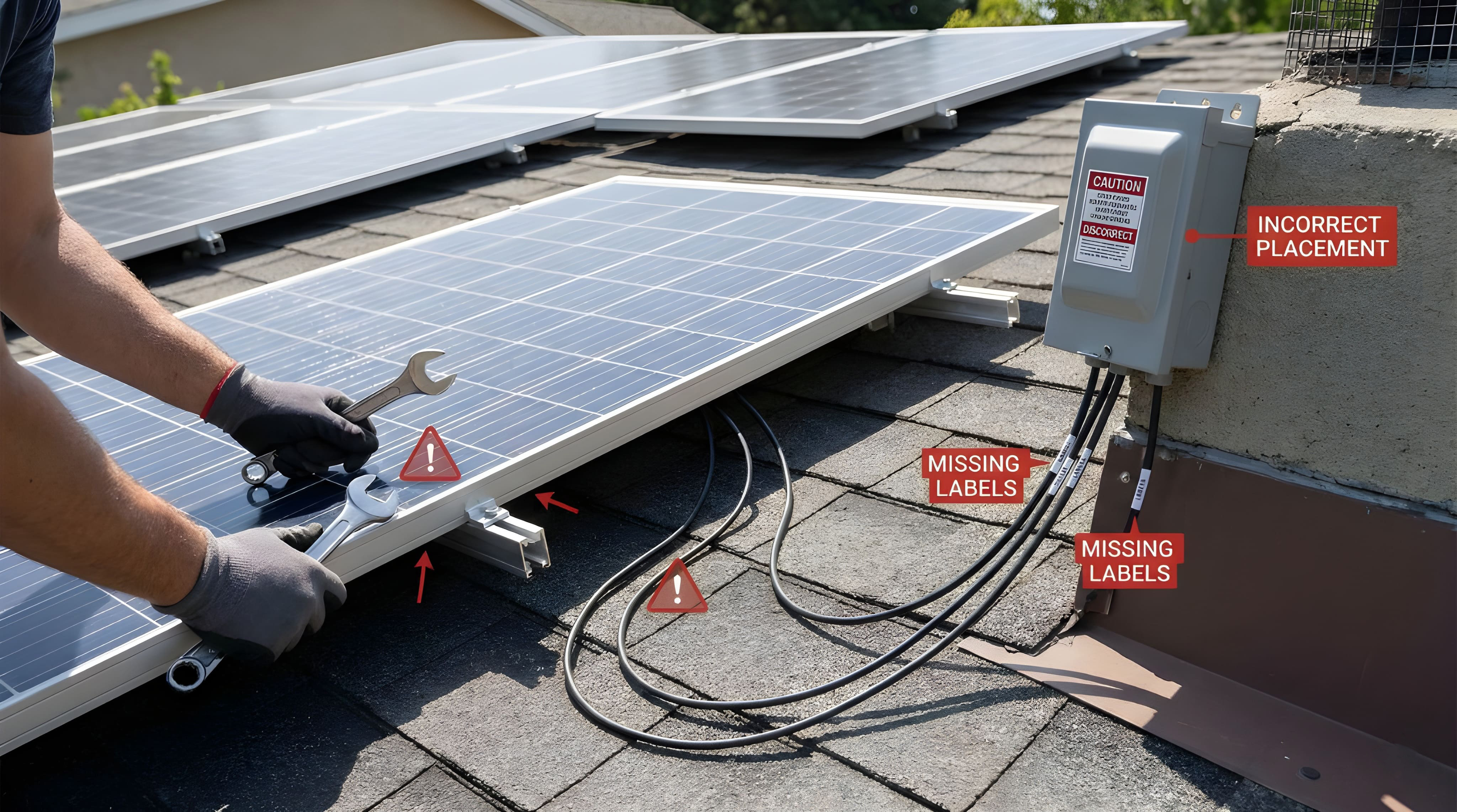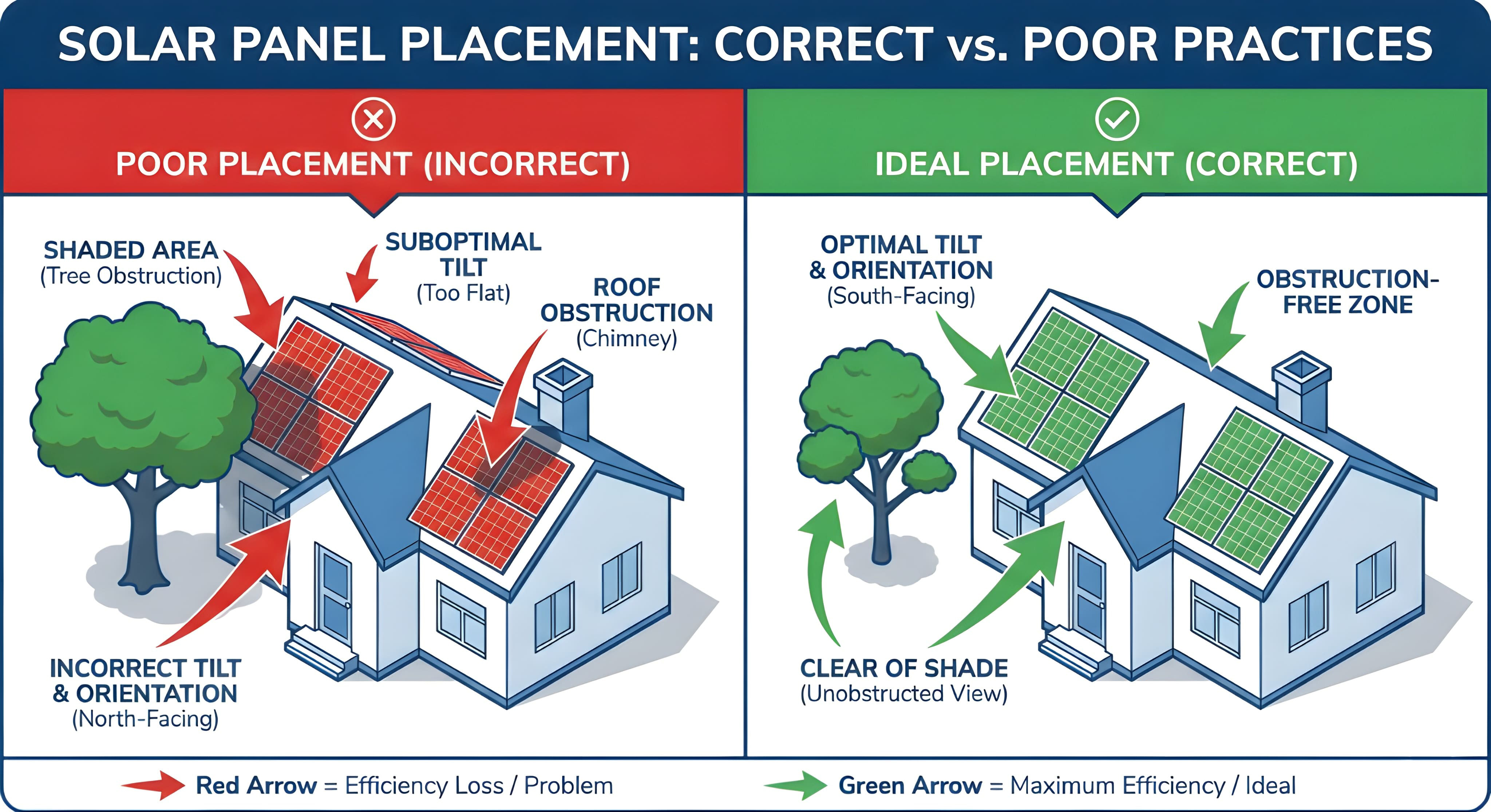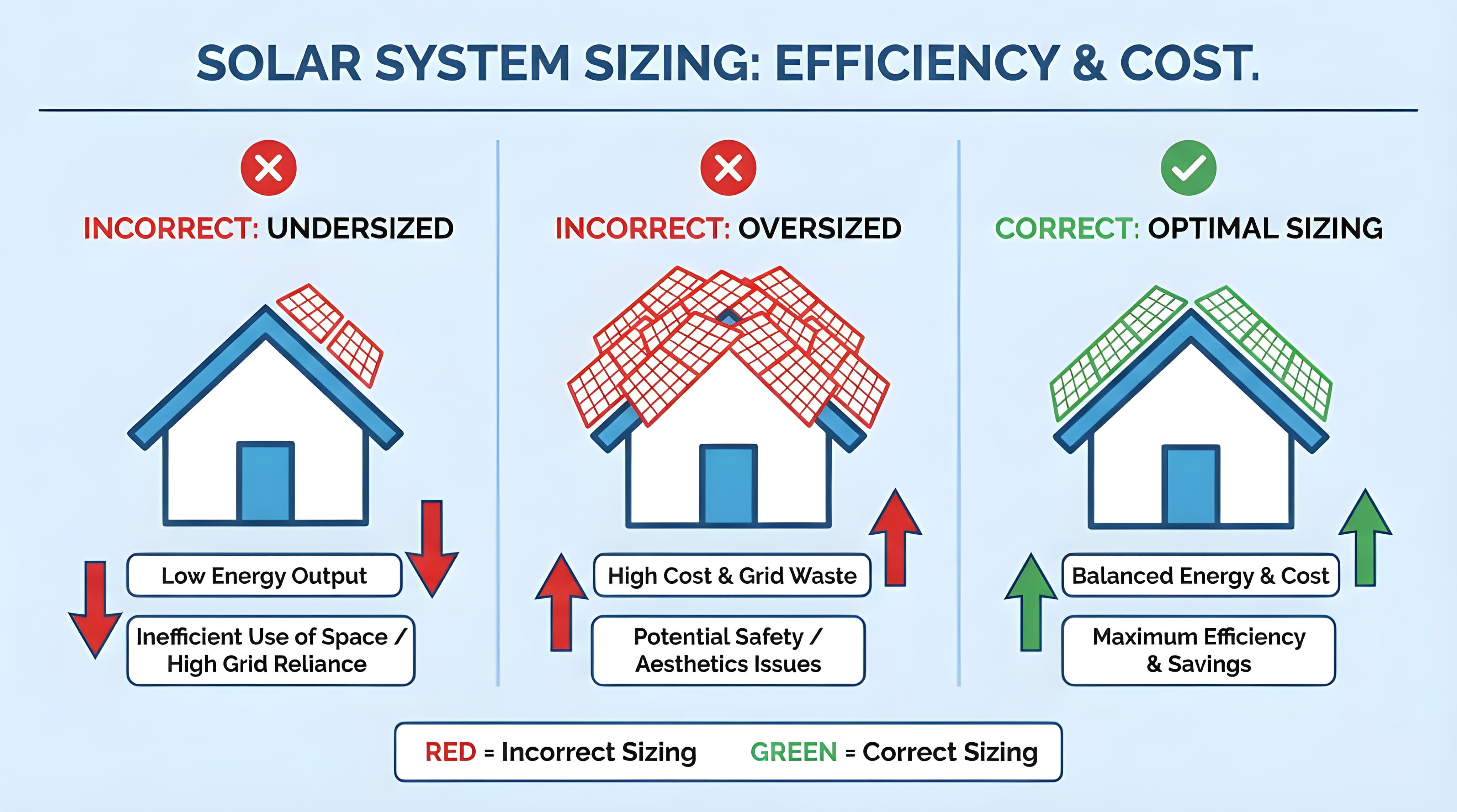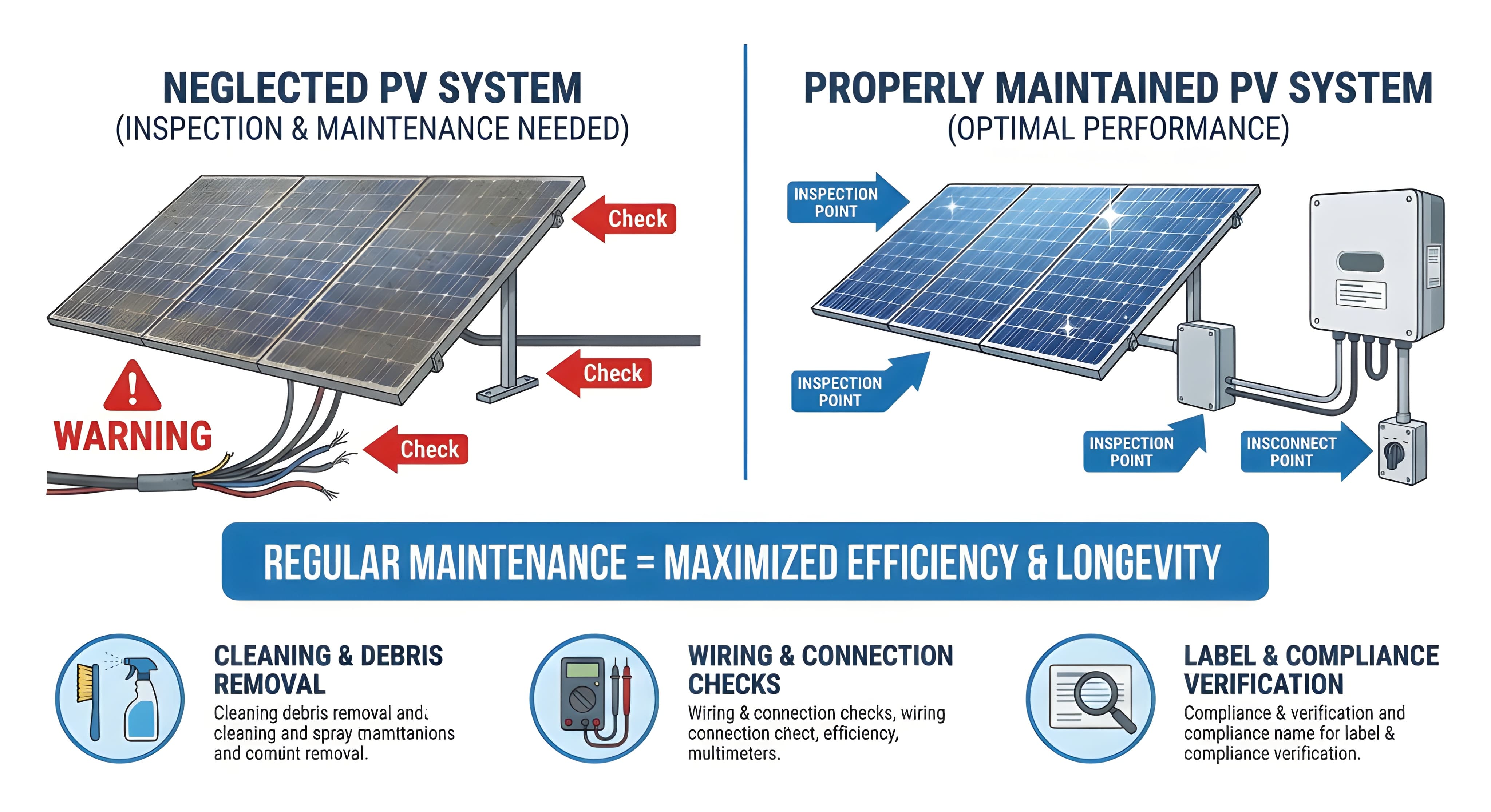

DIY solar panel installation mistakes cost homeowners thousands in reduced efficiency, safety hazards, and repair expenses. The six most common errors include choosing wrong panel locations, ignoring building codes, improper electrical wiring, miscalculating system capacity, poor mounting techniques, and neglecting maintenance. Each mistake significantly impacts solar system performance, energy savings, and household safety.
Property owners attempting self-installation to save money often underestimate the technical complexity involved. Poor panel placement alone can reduce energy output by 50% or more. Electrical wiring errors create fire risks and potential electrocution hazards. Non-compliance with local building codes results in fines, voided warranties, and insurance complications.
This guide examines the six critical errors that occur during DIY solar panel setup and provides actionable solutions to prevent them. Understanding these specific pitfalls proves essential for anyone planning residential solar installation. The information covers site assessment, regulatory compliance, electrical safety standards, capacity calculations, installation techniques, and ongoing maintenance requirements that determine whether a solar system succeeds or fails.

Among the most frequent DIY solar panel installation errors is choosing an unsuitable site for the panels. Solar panel efficiency depends heavily on location, as it directly influences sunlight exposure. A poorly chosen location can substantially diminish the energy output of the system, resulting in underwhelming performance and decreased energy savings.
To prevent faulty installation, careful evaluation of optimal roof sections and angles for solar exposure becomes crucial. According to the Department of Energy, solar panels should ideally be mounted on a south-facing roof to maximize sun exposure throughout the day. Additionally, panel angles should be adjusted based on specific latitude to optimize solar energy absorption.
Assessment of surrounding elements such as trees, buildings, or other structures that might create shadows during daylight hours also proves vital. Even partial shading can dramatically reduce the efficiency of a solar panel array. Conducting a comprehensive site assessment before installation ensures that solar panels are positioned for maximum productivity and longevity.
Following proper installation guidance and remaining aware of potential hazards can significantly improve the success of residential solar projects. For more insights, explore our blog for detailed guides. Taking time to plan and evaluate the installation site can prevent future problems and ensure optimal solar energy generation.
When installing solar panels independently, adherence to local building codes and regulations proves crucial. Overlooking these requirements can lead to severe consequences, including safety hazards, fines, and problems with insurance coverage. Local codes are designed to ensure all installations remain safe and effective, protecting both the property owner and the broader community.
Local building codes frequently specify requirements for solar panel system mounting, acceptable materials, and proper electrical wiring procedures. Research from NREL shows that regulatory non-compliance ranks among the costliest errors homeowners make. The ICC solar standards provide comprehensive guidelines for safe installations. Compliance with local codes ensures the solar system possesses sufficient strength to withstand local environmental stresses.
To avoid common installation mistakes, consulting with Solar Permit Solutions or local authorities before beginning the project proves advisable. Understanding permit requirements and necessary inspections required to legally and safely install solar panels at home provides clarity. For state-specific guidance, review California's regulations as an example of comprehensive permitting frameworks.
Respecting local building codes during a DIY solar panel project remains important to safeguard the investment and contribute to overall success and reliability of the renewable energy source. This adherence prevents legal complications while ensuring a safe and compliant installation.

Improper electrical connections present significant risks in DIY solar panel installations. DIY enthusiasts frequently underestimate the complexities involved in the electrical aspects of solar panel setup. This oversight can lead to serious safety hazards, including electrical fires and shocks. Ensuring that all wiring is correctly rated for its purpose and properly installed remains crucial to avoid such dangers.
An essential tip for maintaining electrical safety involves using only equipment meeting standards and complying with national and local electrical codes. According to Purdue Extension, ensuring all connections are tight and secure can prevent potential failures. For those without professional electrician training, seeking professional assistance when dealing with the electrical side of solar panel installation is highly advised.
Another common mistake in DIY solar panel installation involves the temptation to improvise or use makeshift solutions. The Consumer Financial Protection Bureau warns about safety risks associated with improper installations. Such practices not only compromise solar system efficiency but also endanger household safety. Proper management of solar panel wiring requires using the correct tools, materials, and techniques to establish connections that are both efficient and safe.
Following essential electrical safety guidelines and avoiding common dangers ensures a safer, more reliable, and efficient solar panel system at home. When dealing with electricity, cutting corners can have severe consequences, so safety and precision should always remain priorities in installation.

One of the most common mistakes in DIY solar panel installation involves miscalculating the solar system's capacity requirements. Property owners often either underestimate or overestimate their energy requirements, which can lead to significant inefficiencies in system performance.
To accurately determine the appropriate solar system size for a home, calculating the household's average energy consumption becomes essential. This involves reviewing past utility bills to understand energy usage patterns. Washington State University recommends considering future changes such as adding an electric vehicle or expanding the home to help forecast increased energy needs.
Considering peak sunlight hours in the area to estimate potential solar energy that can be harnessed also proves important. Professional design services can provide accurate calculations based on regional data. Understanding solar standards helps ensure proper system specifications. Average peak sunlight hours might differ significantly across regions, impacting solar energy generation efficiency.
Correctly sizing a solar system not only optimizes its efficiency but also enhances return on investment by ensuring unnecessary capacity isn't purchased or insufficient power provided. Following these steps and utilizing detailed installation guidance can help avoid common permit mistakes and establish a system that meets energy needs.
Correct installation proves crucial for optimal DIY solar panel performance. Common installation mistakes often stem from poor mounting and alignment, which can drastically affect system efficiency. According to PV Magazine, incorrect installation can lead to issues such as reduced energy output and increased wear and tear, potentially compromising solar panel longevity.
To ensure secure mounting and optimal alignment, following best practices that cater specifically to each setup becomes essential. Proper mounting involves using appropriate tools and materials that can withstand environmental factors like wind and rain, especially in areas where weather can be unpredictable. Additionally, panels should be precisely aligned to maximize sun exposure throughout the day. Ensuring panels face the right direction and are tilted at the correct angle relative to the sun's position proves key to capturing the maximum amount of solar energy.
Avoiding installation faults begins with careful planning and understanding common pitfalls of DIY setups. By adhering to recommended installation guidance and being aware of potential dangers, homeowners can significantly enhance the performance and reliability of their solar power systems.
Those considering home solar panel installation should first consult with professionals or utilize detailed guides to troubleshoot effectively. Commercial projects require even more specialized expertise to ensure the installation is safe, efficient, and capable of providing maximum energy output.

Maintaining and troubleshooting a DIY solar panel system proves crucial for sustaining its efficiency and longevity. Neglecting regular maintenance can lead to decreased energy production and potential system failures, which can be costly to repair. Understanding the importance of ongoing maintenance and being equipped with basic troubleshooting capabilities remain essential for any solar panel owner.
Regular cleaning of solar panels represents one of the simplest yet most effective maintenance practices. Dust, debris, and other materials can accumulate on panels and significantly block sunlight, reducing system efficiency. This guide emphasizes ensuring panels remain clean and free from obstructions to allow them to operate at optimal capacity.
Additionally, regularly checking the connections and wiring of the solar panel system proves important. Loose connections or damaged wires can not only reduce system performance but also pose serious safety hazards. Basic troubleshooting steps, such as visually inspecting the system for any signs of damage or wear and testing connections, can help identify and rectify common issues before they escalate.
For more complex issues or uncertainty about how to proceed, calling a professional is recommended. Troubleshooting DIY solar panels can sometimes require specific technical knowledge, and professional input can ensure the system continues to function safely and efficiently.
While DIY solar panel installation may appear cost-effective initially, the risks and complexities involved often outweigh the potential savings. The six common errors outlined above demonstrate how easily a well-intentioned project can result in reduced efficiency, safety hazards, or costly repairs.
Professional solar installers bring specialized expertise that addresses each of these potential pitfalls. Their experience with proper panel positioning, compliance with permit regulations nationwide, electrical safety protocols, accurate system sizing, secure mounting techniques, and ongoing maintenance ensures optimal system performance from day one.
Beyond technical knowledge, professionals provide warranties, insurance coverage, and peace of mind that DIY installations cannot match. They navigate permit processing, understand regional weather considerations, and employ industry best practices developed over years of installations. Utility Dive highlights common issues with improperly installed residential systems.
For homeowners committed to solar energy, partnering with qualified professionals represents the most reliable path to a safe, efficient, and long-lasting solar power system. The investment in professional installation pays dividends through maximized energy production, minimized risk, and enhanced system longevity.
What is the most critical mistake to avoid when installing solar panels?
The most critical mistake involves improper electrical wiring and connections. Electrical errors can lead to serious safety hazards including fires, shocks, and system failures. Unlike other mistakes that primarily affect efficiency, electrical issues pose immediate dangers to both property and personal safety. Anyone without professional electrician training should always seek expert assistance for the electrical components of solar installation.
How do local building codes affect DIY solar panel installation?
Local building codes dictate specific requirements for solar panel mounting, materials, electrical wiring, and structural integrity. Failing to comply with these regulations can result in fines, forced removal of the system, voided warranties, and insurance coverage issues. Additionally, non-compliant installations may not qualify for solar incentives or rebates. Understanding Texas requirements or your local regulations before beginning installation ensures the project meets all legal requirements.
Can partial shading really affect solar panel performance that much?
Yes, even partial shading can dramatically reduce solar panel efficiency. When one section of a panel or array is shaded, it can decrease the output of the entire system due to how solar cells are connected in series. A shadow covering just 10% of a panel can reduce its output by 50% or more in some cases. This makes proper site assessment and panel positioning crucial for maximizing energy production.
How often should solar panels be cleaned and maintained?
Solar panels should be visually inspected monthly and cleaned at least twice per year, though frequency depends on local conditions. Areas with high dust, pollen, or bird activity may require more frequent cleaning. Additionally, annual professional inspections are recommended to check electrical connections, mounting hardware, and overall system performance. Regular maintenance prevents minor issues from becoming costly repairs and ensures optimal energy production.
Is it possible to expand a DIY solar system later if energy needs increase?
While technically possible, expanding a DIY solar system can be complicated and may require significant modifications to the existing setup. Factors like inverter capacity, roof space, electrical panel upgrades, and permit requirements all come into play. Exploring off-grid systems during initial planning proves far more cost-effective than retrofitting later. This is another reason why proper initial system sizing and professional consultation are valuable investments.
We are dedicated to providing top-notch solar permit services to homeowners, business owners, DIY, and solar installers. Contact us today.